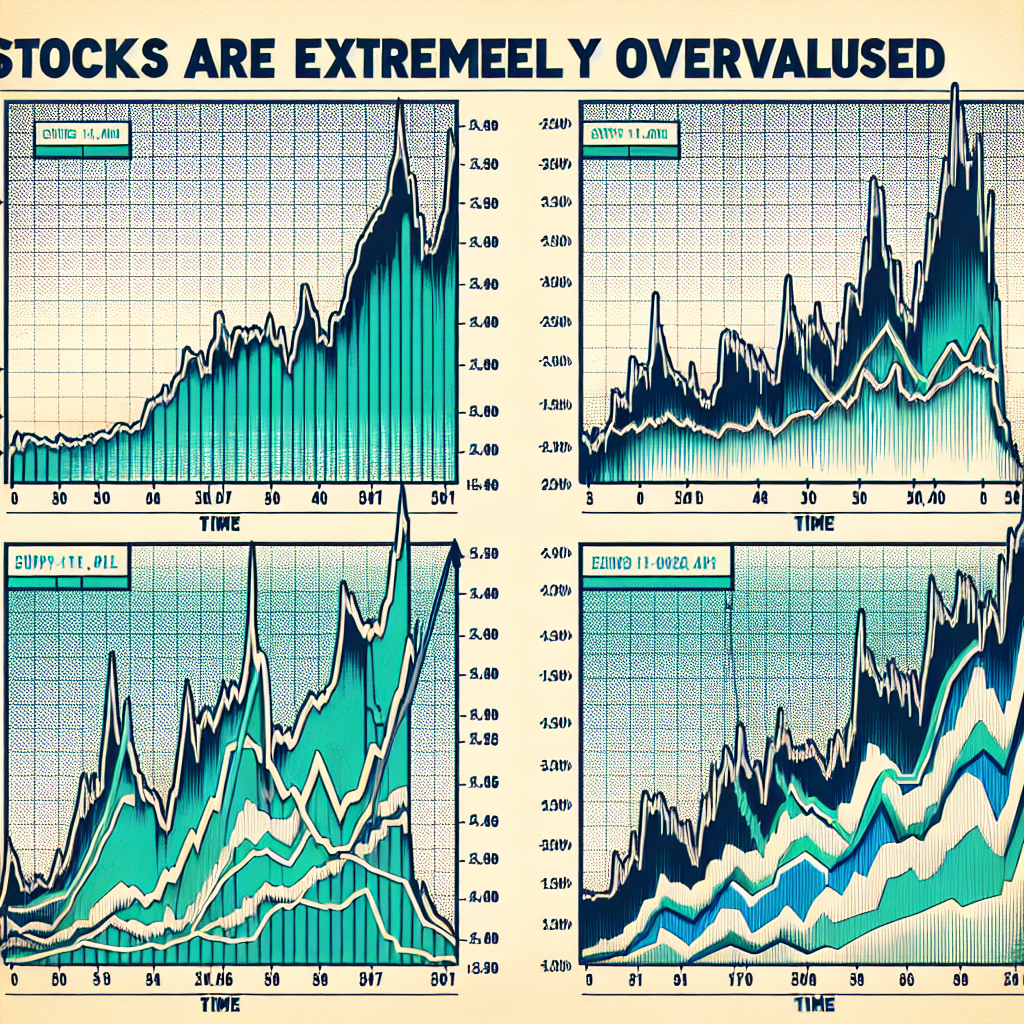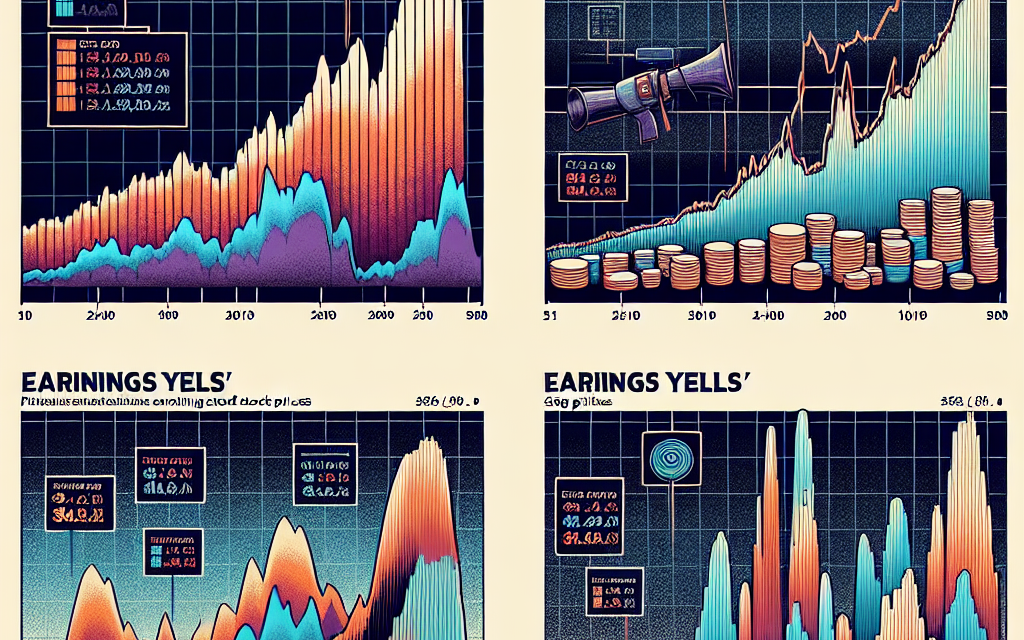“Unmasking the Bubble: 5 Charts Expose the Overvaluation Surge in Stocks”
Introduction
In recent years, the stock market has experienced a remarkable surge, raising concerns among investors and analysts about potential overvaluation. This introduction delves into the phenomenon of overvalued stocks, highlighting five key charts that illustrate the extent of this surge. These charts provide a visual representation of market trends, price-to-earnings ratios, and other critical indicators that suggest stocks may be trading at levels significantly higher than their intrinsic value. By examining these charts, we can gain a deeper understanding of the current market dynamics and the potential risks associated with investing in an overheated market.
Historical Comparisons: How Current Valuations Stack Up Against Past Market Peaks
In the realm of financial markets, the valuation of stocks is a topic that consistently garners attention, particularly when prices soar to unprecedented levels. The current market environment has prompted many analysts to draw comparisons with historical peaks, raising concerns about the sustainability of such valuations. By examining five key charts, we can gain a clearer understanding of how today’s stock valuations compare to those of past market peaks, offering insights into the potential risks and implications for investors.
To begin with, the price-to-earnings (P/E) ratio, a widely used metric for assessing stock valuations, provides a telling picture. Historically, elevated P/E ratios have often preceded market corrections. Currently, the P/E ratio for the S&P 500 hovers well above its long-term average, reminiscent of levels seen during the dot-com bubble of the late 1990s. This suggests that investors are paying a premium for earnings, which may not be sustainable if corporate profits fail to meet expectations. As we delve deeper, it becomes evident that this is not an isolated phenomenon but part of a broader trend.
Transitioning to another critical measure, the cyclically adjusted price-to-earnings (CAPE) ratio, developed by economist Robert Shiller, offers a more comprehensive view by smoothing out earnings over a ten-year period. The current CAPE ratio is alarmingly high, rivaling the peaks observed before the Great Depression and the 2008 financial crisis. This historical context underscores the potential for significant market corrections, as such elevated levels have historically been followed by periods of lower returns.
Moreover, the market capitalization-to-GDP ratio, often referred to as the “Buffett Indicator,” provides further evidence of overvaluation. This ratio compares the total market value of publicly traded stocks to the overall economic output of a country. Presently, this indicator is at levels that surpass those seen during previous market peaks, including the dot-com era. Such a disparity between market valuations and economic fundamentals raises questions about the sustainability of current stock prices.
In addition to these valuation metrics, the equity risk premium, which measures the excess return that investing in stocks provides over a risk-free rate, is also at historically low levels. This suggests that investors are not being adequately compensated for the risks associated with holding equities, a situation that has often preceded market downturns. The low equity risk premium highlights the potential vulnerability of the market to adverse economic or geopolitical events.
Finally, examining the yield curve, which plots interest rates across different maturities, reveals another layer of concern. An inverted yield curve, where short-term interest rates exceed long-term rates, has historically been a reliable predictor of recessions. While the yield curve is not currently inverted, it remains unusually flat, indicating investor uncertainty about future economic growth. This uncertainty, coupled with high stock valuations, paints a precarious picture for the market.
In conclusion, these five charts collectively illustrate the extent to which current stock valuations are elevated compared to historical norms. While markets can remain overvalued for extended periods, the convergence of these indicators suggests that caution is warranted. Investors should be mindful of the potential for market corrections and consider the implications of these historical comparisons as they navigate the complexities of today’s financial landscape.
Price-to-Earnings Ratios: Analyzing the Skyrocketing Metrics
In recent years, the stock market has experienced a remarkable surge, leading to widespread discussions about the sustainability of current valuations. One of the most telling indicators of this phenomenon is the price-to-earnings (P/E) ratio, a metric that provides insight into how much investors are willing to pay for a dollar of earnings. Historically, the P/E ratio has served as a reliable gauge of market sentiment, and its current levels suggest that stocks are extremely overvalued. To understand the extent of this surge, it is essential to examine several key charts that highlight the dramatic rise in P/E ratios across various sectors.
Firstly, the overall market P/E ratio has reached levels not seen since the dot-com bubble of the late 1990s. This is particularly evident in the S&P 500, where the average P/E ratio has soared well above its historical average. Such elevated levels indicate that investors are pricing in significant future growth, which may not be sustainable given the current economic climate. Moreover, when comparing today’s P/E ratios to those of previous market peaks, it becomes apparent that the current valuations are among the highest in history, raising concerns about potential market corrections.
Transitioning to specific sectors, the technology industry stands out with its exceptionally high P/E ratios. This sector has been a major driver of the market’s overall growth, fueled by rapid advancements and the increasing digitization of the global economy. However, the enthusiasm surrounding tech stocks has led to valuations that far exceed their historical norms. For instance, companies within the tech-heavy NASDAQ index are trading at multiples that suggest an optimistic outlook for future earnings, yet such optimism may not be justified if growth expectations are not met.
In addition to technology, the consumer discretionary sector has also witnessed a significant rise in P/E ratios. This sector, which includes companies that sell non-essential goods and services, has benefited from increased consumer spending and a robust economic recovery. However, the elevated P/E ratios in this sector suggest that investors are betting on continued consumer strength, which could be vulnerable to shifts in economic conditions or changes in consumer behavior.
Furthermore, the healthcare sector, traditionally viewed as a defensive play, has not been immune to the surge in valuations. The P/E ratios for healthcare stocks have climbed as investors anticipate continued innovation and demand for medical services. While the long-term prospects for healthcare remain strong, the current valuations may not fully account for potential regulatory challenges or shifts in healthcare policy that could impact earnings.
Finally, it is important to consider the impact of low interest rates on P/E ratios. The prolonged period of historically low interest rates has driven investors to seek higher returns in the stock market, contributing to the rise in valuations. However, as central banks signal potential rate hikes to combat inflation, the cost of borrowing may increase, potentially dampening investor enthusiasm and leading to a reevaluation of current stock prices.
In conclusion, the analysis of P/E ratios across various sectors reveals a market characterized by extreme overvaluation. While the optimism driving these valuations is rooted in expectations of future growth, it is crucial for investors to remain vigilant and consider the potential risks associated with such elevated levels. As history has shown, markets can be unpredictable, and maintaining a balanced perspective is essential in navigating the complexities of today’s investment landscape.
Market Sentiment: Understanding the Role of Investor Psychology in Overvaluation
Investor psychology plays a pivotal role in the valuation of stocks, often driving prices to levels that may not be justified by fundamental analysis. The current market environment is a testament to this phenomenon, as stocks appear to be extremely overvalued. This overvaluation is not merely a result of strong corporate earnings or economic growth; rather, it is significantly influenced by the collective sentiment of investors. Understanding this sentiment is crucial for comprehending the extent of the surge in stock prices, as illustrated by five revealing charts.
To begin with, the Price-to-Earnings (P/E) ratio, a widely used metric for assessing stock valuation, has reached levels reminiscent of past market bubbles. Historically, a high P/E ratio suggests that investors are willing to pay more for each dollar of earnings, often driven by optimism about future growth. However, when this optimism becomes excessive, it can lead to unsustainable price levels. The current P/E ratios for many major indices are well above their historical averages, indicating that investor expectations may be overly optimistic.
Moreover, the Shiller P/E ratio, which adjusts for inflation and provides a longer-term perspective, further underscores the overvaluation. This metric smooths out short-term fluctuations and offers a clearer view of market trends. Presently, the Shiller P/E ratio is approaching levels seen during the dot-com bubble, suggesting that the market may be in a speculative phase. This is a clear indication that investor psychology, rather than fundamentals, is driving the market.
In addition to these valuation metrics, the surge in stock prices can also be attributed to the unprecedented levels of liquidity in the financial system. Central banks around the world have implemented expansive monetary policies, injecting vast amounts of capital into the markets. This influx of liquidity has lowered interest rates, making equities more attractive compared to fixed-income investments. Consequently, investors have been driven to seek higher returns in the stock market, further inflating prices. This behavior is often fueled by the fear of missing out, a powerful psychological driver that can lead to irrational investment decisions.
Furthermore, the role of retail investors cannot be overlooked in the current market dynamics. The rise of commission-free trading platforms and the increased accessibility of financial markets have empowered individual investors like never before. This democratization of investing has led to a surge in retail participation, often characterized by speculative trading and herd behavior. Social media platforms have amplified this effect, enabling the rapid spread of market narratives and contributing to the formation of asset bubbles.
Finally, the volatility index, commonly known as the VIX, provides insight into market sentiment and investor psychology. Despite the high valuations, the VIX has remained relatively low, indicating complacency among investors. This complacency can be dangerous, as it suggests that investors are underestimating potential risks and are overly confident in the market’s continued upward trajectory. Such sentiment can lead to abrupt corrections when reality fails to meet expectations.
In conclusion, the current overvaluation of stocks is a complex interplay of investor psychology, liquidity conditions, and market dynamics. While fundamental factors do play a role, it is the collective sentiment of investors that has driven prices to their current levels. By examining these five charts, it becomes evident that understanding market sentiment is essential for navigating the challenges and opportunities presented by an overvalued market. As history has shown, markets driven by sentiment can be volatile and unpredictable, underscoring the importance of a cautious and informed approach to investing.
Sector Analysis: Identifying Which Industries Are Driving the Overvaluation

In recent years, the stock market has experienced a remarkable surge, leading to widespread concerns about overvaluation. This phenomenon is not uniform across all sectors; rather, it is driven by specific industries that have seen unprecedented growth. By examining key sectors, we can better understand which industries are contributing most significantly to the current overvaluation of stocks.
To begin with, the technology sector has been a major driver of stock market growth. Companies within this industry have benefited from rapid advancements in digital innovation, leading to increased investor enthusiasm. The proliferation of cloud computing, artificial intelligence, and e-commerce has fueled a surge in stock prices, often outpacing the actual earnings growth of these companies. As a result, the price-to-earnings ratios in the tech sector have reached levels that many analysts consider unsustainable. This disconnect between stock prices and fundamental value is a primary indicator of overvaluation.
Transitioning to another influential sector, the healthcare industry has also played a significant role in the current market dynamics. The COVID-19 pandemic accelerated investment in pharmaceutical and biotechnology companies, as they were at the forefront of vaccine development and distribution. While this led to substantial short-term gains, the long-term sustainability of such valuations is questionable. The rapid rise in stock prices, driven by speculative investments, has contributed to the overall market overvaluation, raising concerns about potential corrections.
Moreover, the consumer discretionary sector has experienced a notable increase in stock valuations. This sector includes companies that produce non-essential goods and services, such as luxury items and entertainment. The pandemic-induced shift in consumer behavior, coupled with increased disposable income from government stimulus measures, has led to a surge in demand for these products. Consequently, stock prices in this sector have risen sharply. However, as economic conditions normalize, there is a risk that consumer spending will revert to pre-pandemic levels, potentially leading to a recalibration of stock valuations.
In addition to these sectors, the financial industry has also contributed to the current market overvaluation. Low interest rates and accommodative monetary policies have encouraged borrowing and investment, driving up stock prices in this sector. Banks and financial institutions have reported strong earnings, but the sustainability of these earnings in a changing economic environment remains uncertain. As interest rates begin to rise, the cost of borrowing will increase, potentially impacting profitability and leading to a reassessment of stock valuations.
Finally, the energy sector, traditionally a more stable component of the market, has seen fluctuations that contribute to the broader overvaluation narrative. The transition towards renewable energy sources and the volatility in oil prices have created a complex landscape for investors. While some companies have thrived by adapting to new energy trends, others have struggled, leading to a mixed impact on stock valuations. The uncertainty surrounding energy policies and global demand further complicates the outlook for this sector.
In conclusion, the overvaluation of stocks is a multifaceted issue driven by specific industries that have experienced rapid growth and speculative investment. The technology, healthcare, consumer discretionary, financial, and energy sectors each play a role in this complex narrative. As investors navigate these turbulent waters, it is crucial to remain vigilant and consider the underlying fundamentals of these industries to make informed decisions. Understanding the drivers of overvaluation can help mitigate risks and identify potential opportunities in an ever-evolving market landscape.
Economic Indicators: Discrepancies Between Stock Prices and Economic Fundamentals
In recent years, the stock market has experienced a remarkable surge, with indices reaching unprecedented heights. However, this meteoric rise has raised concerns among economists and investors alike, as several economic indicators suggest a significant discrepancy between stock prices and underlying economic fundamentals. To better understand this phenomenon, it is essential to examine five key charts that reveal the extent of the overvaluation in the stock market.
Firstly, the price-to-earnings (P/E) ratio, a widely used metric to assess stock valuation, has reached levels not seen since the dot-com bubble of the late 1990s. Historically, a high P/E ratio indicates that stocks are overvalued relative to their earnings potential. Currently, the P/E ratio for major indices is well above historical averages, suggesting that investors are paying a premium for stocks without a corresponding increase in earnings. This disconnect raises questions about the sustainability of current stock prices, especially in the face of potential economic headwinds.
Moreover, the cyclically adjusted price-to-earnings (CAPE) ratio, which smooths out earnings over a ten-year period to account for economic cycles, also points to overvaluation. The CAPE ratio is currently at levels that have historically preceded market corrections. This indicator suggests that the market may be pricing in overly optimistic future earnings growth, which may not materialize if economic conditions deteriorate. As such, the elevated CAPE ratio serves as a cautionary signal for investors who may be overly bullish on the market’s prospects.
In addition to valuation metrics, the divergence between stock prices and economic growth further underscores the overvaluation issue. While stock indices have soared, GDP growth has remained relatively modest. This disparity suggests that stock prices are being driven more by investor sentiment and speculative behavior than by actual improvements in economic fundamentals. The disconnect between stock market performance and economic growth raises concerns about the potential for a market correction if investor sentiment shifts.
Furthermore, the bond yield spread, which measures the difference between long-term and short-term interest rates, has narrowed significantly. A narrowing yield spread often signals investor concerns about future economic growth, as it indicates a preference for the safety of long-term bonds over riskier assets like stocks. Despite this cautionary signal from the bond market, stock prices continue to climb, highlighting the growing disconnect between investor behavior and economic indicators.
Lastly, corporate debt levels have reached all-time highs, adding another layer of risk to the current market environment. Companies have taken advantage of low interest rates to finance stock buybacks and other shareholder-friendly activities, rather than investing in productive assets. This trend has contributed to inflated stock prices, as buybacks reduce the number of shares outstanding and artificially boost earnings per share. However, the reliance on debt to support stock prices raises concerns about the long-term sustainability of this strategy, particularly if interest rates rise or economic conditions worsen.
In conclusion, the current stock market surge appears to be at odds with several key economic indicators, suggesting that stocks are extremely overvalued. The elevated P/E and CAPE ratios, the divergence between stock prices and economic growth, the narrowing bond yield spread, and rising corporate debt levels all point to a market that may be vulnerable to a correction. Investors should remain vigilant and consider these discrepancies when making investment decisions, as the current environment presents both opportunities and significant risks.
Global Perspective: Comparing U.S. Stock Valuations to International Markets
In recent years, the valuation of U.S. stocks has become a topic of intense scrutiny and debate among investors and analysts alike. As the market continues to reach unprecedented heights, concerns about overvaluation have grown, prompting a closer examination of how U.S. stock valuations compare to those in international markets. By analyzing key metrics and trends, we can gain a clearer understanding of the extent to which U.S. stocks are overvalued relative to their global counterparts.
To begin with, the price-to-earnings (P/E) ratio, a widely used measure of stock valuation, offers a revealing glimpse into the current state of the U.S. market. Historically, the average P/E ratio for U.S. stocks has hovered around 15 to 16. However, recent data indicates that this ratio has surged well beyond historical norms, reaching levels that are significantly higher than those observed in many other developed markets. For instance, while the P/E ratio for U.S. stocks has climbed above 20, markets in Europe and Asia have maintained more moderate ratios, often below 15. This disparity suggests that U.S. stocks are priced at a premium compared to their international peers.
Moreover, the cyclically adjusted price-to-earnings (CAPE) ratio, which accounts for inflation-adjusted earnings over a 10-year period, further underscores the overvaluation of U.S. stocks. The CAPE ratio for the U.S. market has reached levels reminiscent of past market bubbles, such as those seen during the dot-com boom of the late 1990s. In contrast, the CAPE ratios for many international markets remain closer to their historical averages, indicating a more balanced valuation landscape outside the United States.
In addition to these valuation metrics, the price-to-book (P/B) ratio provides another lens through which to assess the relative valuation of U.S. stocks. The P/B ratio compares a company’s market value to its book value, offering insight into how much investors are willing to pay for a company’s net assets. Currently, the P/B ratio for U.S. stocks is significantly higher than that of many international markets, suggesting that investors are paying a substantial premium for U.S. equities.
Furthermore, the dividend yield, which measures the annual dividend income relative to the stock price, highlights another dimension of the valuation disparity. U.S. stocks currently offer lower dividend yields compared to many international markets, reflecting higher stock prices relative to the income generated. This trend indicates that investors in U.S. stocks may be accepting lower income returns in exchange for the perceived growth potential, further contributing to the overvaluation narrative.
Finally, the market capitalization-to-GDP ratio, often referred to as the “Buffett Indicator,” provides a macroeconomic perspective on stock valuations. This ratio compares the total market capitalization of a country’s stock market to its gross domestic product (GDP). In the U.S., this ratio has reached levels that are historically associated with market overvaluation, surpassing those of most other major economies. This suggests that the U.S. stock market is valued at a level that may not be sustainable given the underlying economic fundamentals.
In conclusion, a comprehensive analysis of various valuation metrics reveals that U.S. stocks are indeed overvalued when compared to international markets. The elevated P/E, CAPE, and P/B ratios, coupled with lower dividend yields and a high market capitalization-to-GDP ratio, all point to a market that is priced at a premium. As investors navigate this complex landscape, understanding these valuation dynamics is crucial for making informed investment decisions in an increasingly interconnected global market.
Risk Management: Strategies for Investors in an Overvalued Market
In the current financial landscape, investors are increasingly concerned about the overvaluation of stocks, a sentiment underscored by a series of compelling charts that illustrate the extent of the market surge. As stock prices continue to climb, the risk of a market correction looms large, prompting investors to reassess their strategies in order to safeguard their portfolios. Understanding the dynamics of an overvalued market is crucial for effective risk management, and adopting a proactive approach can help mitigate potential losses.
One of the most telling indicators of market overvaluation is the price-to-earnings (P/E) ratio, which has reached levels not seen since the dot-com bubble of the late 1990s. This metric, which compares a company’s share price to its earnings per share, suggests that investors are paying a premium for stocks relative to their actual earnings. As the P/E ratio continues to rise, it becomes increasingly important for investors to exercise caution and consider the implications of investing in an overheated market.
In addition to the P/E ratio, the Shiller P/E ratio, or cyclically adjusted price-to-earnings ratio, offers further insight into market valuation. This measure accounts for inflation and provides a more comprehensive view of long-term market trends. Currently, the Shiller P/E ratio is significantly above its historical average, indicating that stocks are priced well above their intrinsic value. This overvaluation raises concerns about the sustainability of current market levels and the potential for a sharp downturn.
Another chart that highlights the extent of the market surge is the Buffett Indicator, which compares the total market capitalization of U.S. stocks to the country’s gross domestic product (GDP). Named after renowned investor Warren Buffett, this indicator suggests that when the market cap-to-GDP ratio exceeds 100%, stocks are overvalued. Presently, this ratio is at an all-time high, signaling that the market is in uncharted territory and may be due for a correction.
Moreover, the rapid rise in stock prices has been accompanied by a surge in margin debt, which refers to the amount of money investors borrow to purchase stocks. High levels of margin debt can exacerbate market volatility, as investors may be forced to sell their holdings quickly in response to margin calls, thereby accelerating a market decline. The current levels of margin debt are reminiscent of previous market peaks, further underscoring the risks associated with an overvalued market.
Given these indicators, investors must adopt robust risk management strategies to navigate the challenges of an overvalued market. Diversification remains a cornerstone of effective risk management, as spreading investments across various asset classes can help reduce exposure to any single market downturn. Additionally, maintaining a disciplined approach to asset allocation and regularly rebalancing portfolios can ensure that investors are not overly concentrated in overvalued sectors.
Furthermore, investors should consider incorporating hedging strategies, such as options or inverse exchange-traded funds (ETFs), to protect against potential losses. These tools can provide a buffer against market volatility and offer peace of mind in uncertain times. Lastly, maintaining a long-term perspective and focusing on fundamental analysis can help investors identify opportunities that align with their risk tolerance and investment objectives.
In conclusion, while the current market environment presents significant challenges, informed investors can employ a range of strategies to manage risk effectively. By staying vigilant and adapting to changing market conditions, investors can navigate the complexities of an overvalued market and position themselves for long-term success.
Q&A
1. **Question:** What is the current price-to-earnings (P/E) ratio of the S&P 500, and how does it compare to historical averages?
– **Answer:** The current P/E ratio of the S&P 500 is significantly above its historical average, indicating potential overvaluation.
2. **Question:** How has the Shiller P/E ratio trended recently, and what does it suggest about market valuation?
– **Answer:** The Shiller P/E ratio has been trending upwards, suggesting that the market is overvalued compared to historical norms.
3. **Question:** What is the current market capitalization to GDP ratio, and what does it imply about stock valuations?
– **Answer:** The market capitalization to GDP ratio is at a historically high level, implying that stocks are overvalued relative to the size of the economy.
4. **Question:** How do current dividend yields compare to historical averages, and what does this indicate about stock prices?
– **Answer:** Current dividend yields are below historical averages, indicating that stock prices may be overvalued.
5. **Question:** What is the trend in corporate earnings growth, and how does it relate to current stock valuations?
– **Answer:** Corporate earnings growth has been sluggish, which does not justify the high stock valuations currently observed.
6. **Question:** How have interest rates impacted stock valuations, according to recent trends?
– **Answer:** Low interest rates have contributed to higher stock valuations, as investors seek returns in equities due to lower yields in fixed income.
7. **Question:** What role has investor sentiment played in the current stock market valuation?
– **Answer:** Investor sentiment has been overly optimistic, driving stock prices higher and contributing to the perception of overvaluation.
Conclusion
The conclusion is that the current stock market exhibits significant overvaluation, as evidenced by various financial metrics and historical comparisons. The five charts highlight the extent of this surge, showing elevated price-to-earnings ratios, inflated market capitalization relative to GDP, and other indicators that suggest prices have risen beyond sustainable levels. This overvaluation raises concerns about potential market corrections and the sustainability of current investment trends, urging investors to exercise caution and consider the underlying economic fundamentals.





